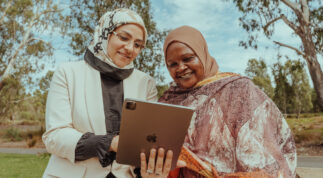Photo: Max Roux for Rural Women Online
Connected digital technologies have changed the way we live, learn, and work. In Australia today, being able to access, afford, and effectively use digital technologies has never been more important to participating fully in society. While digital transformation is generating social, cultural, and economic benefits for many Australians, these benefits are not shared equally.
What is digital inclusion?
The premise of digital inclusion is that everyone should be able to make full use of digital technologies and the benefits they bring, while avoiding their potential negative consequences.
The Australian Digital Inclusion Index (ADII) has provided a national measure of digital inclusion since 2015. It identifies three critical dimensions of digital inclusion: Access, Affordability and Digital Ability.
- Access is about how often and how intensively people are using the internet.
- Affordability is about what proportion of people’s income is necessary for people to get access to quality and reliable internet services.
- Digital Ability is about what people can actually do online and their confidence in doing it.
Bringing all these elements together, the ADII shows that levels of digital inclusion differ across different communities and for people in different circumstances, and that digital and social inequalities are connected.
Who is most impacted by the digital divide?
People on lower incomes, experiencing unemployment, older Australians, public housing residents, and regional and rural communities continue to experience lower levels of digital inclusion.
While the gender gap for digital inclusion is closing both globally and in Australia, some groups of women use the internet less, experience greater affordability barriers, and have lower digital skills and confidence. These include women on lower incomes, with lower levels of education, living alone, and in regional and remote areas. Meanwhile, older women tend to have lower levels of digital confidence and skills and access the internet less than younger women.
Age, employment, income, housing type and tenure, location — understanding all these factors in combination can pinpoint those more vulnerable to digital exclusion. While digital exclusion remains a significant challenge, improving digital skills can support women to fully participate in and take up opportunities on offer in today’s society.
Digital skills can enable women to gain better outcomes
This can be seen across employment, health, training and education, and disaster recovery, whilst also providing life affirming community and familial connections.
By providing essential digital skills, programs such as Rural Women Online, an initiative of the Victorian Women’s Trust, can play a key role in supporting rural women’s resilience, social connectedness, general wellbeing, economic security, and employment opportunities.
This article has been sourced from research by the ARC Centre of Excellence for Automated Decision-Making and Society (ADM+S). To learn more visit: https://www.digitalinclusionindex.org.au/
 Kieran Hegarty is a Research Fellow in the RMIT node of the ADM+S. Kieran’s research explores the relationship between social infrastructure (particularly libraries) and digital technologies. His PhD research examines how online material is incorporated into major public library collections, and the effects that a changing information environment has on the public’s right to access and contribute to the shared cultural record.
Kieran Hegarty is a Research Fellow in the RMIT node of the ADM+S. Kieran’s research explores the relationship between social infrastructure (particularly libraries) and digital technologies. His PhD research examines how online material is incorporated into major public library collections, and the effects that a changing information environment has on the public’s right to access and contribute to the shared cultural record.



